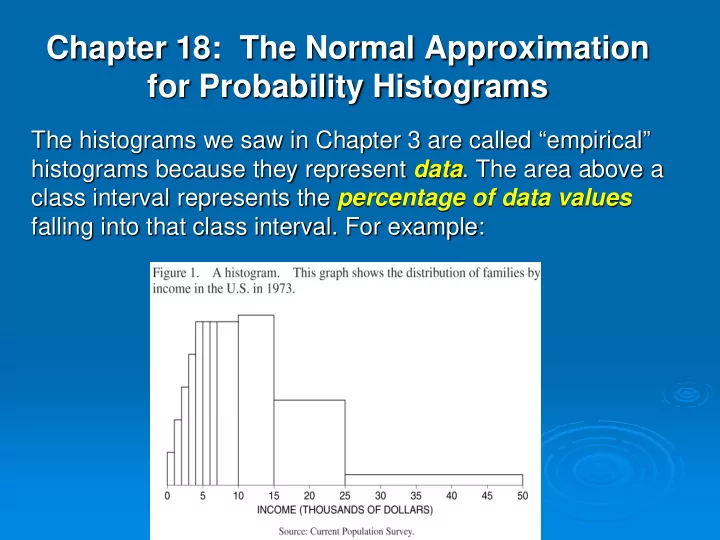

Chapter 18: The Normal Approximation for Probability Histograms The histograms we saw in Chapter 3 are called “empirical” histograms because they represent data . The area above a class interval represents the percentage of data values falling into that class interval. For example:
Probability Histograms Probability histograms represent chance . The area above a class interval represents the chance for that class interval. Example: roll two dice and look at the total number of spots. A probability histogram for this chance process is given by:
We can get a probability histogram for a chance process by finding the chances and doing a histogram. We can get an empirical histogram for a chance process by repeating the process many times and doing a histogram. The more repetitions we do, the closer the empirical histogram will get to the probability histogram .
Roll two dice 100 times and look at the number of spots:
The sum of 2 rolls. The more repetitions we do, the closer the empirical histogram will get to the probability histogram .
The product of 2 rolls. The more repetitions we do, the closer the empirical histogram will get to the probability histogram .
The Normal Curve The probability histogram for the sum of the draws will approximately follow the normal curve if the number of draws is large enough, even if the tickets in the box do not follow the normal curve!
To get standard units, use EVsum and SEsum ave box = 0.5 0 1 SD box = 0.5 EVsum = 100(0.5) = 50 SEsum = ( √ 100 )(0.5) = 5 x – EVsum z = SEsum
The probability histogram and the normal curve for the number of heads when we toss a coin 100 times. This is the sum of 100 draws from the box: 0 1
The sum of the draws. The more draws we do, the closer the probability histogram will get to the normal curve . The box: 0 1 histogram for the box:
The sum of the draws. The more draws we do, the closer the probability histogram will get to the normal curve . The box: 0 1 9 histogram for the box:
The sum of the draws. The more draws we do, the closer the probability histogram will get to the normal curve . The box: 1 2 3 histogram for the box:
The sum of the draws. The more draws we do, the closer the probability histogram will get to the normal curve . The box: 1 2 9 histogram for the box:
Not everything is normal! Sums, averages, percentages are normal. Products are not!
Recommend
More recommend